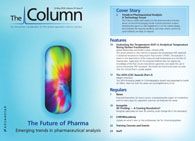Larynx Cancer Biomarkers
Over the last 30 years, the occurrence of head and neck cancer in Spain has been increasing, and now accounts for between 5–10% of malignant tumours diagnosed each year.1 In a new study published in the journal Chromatographia, solid-phase microextraction (SPME) with gas chromatography coupled to mass spectrometry (GC–MS) has been performed to identify two potential biomarkers of epidermoid laryngeal cancer, that could be used in non-invasive diagnostic testing.

Photo Credit: Getty Images/Science Photo Library – PIXOLOGICSTUDIO
Over the last 30 years, the occurrence of head and neck cancer in Spain has been increasing, and now accounts for between 5–10% of malignant tumours diagnosed each year.1 In a new study published in the journal Chromatographia, solid-phase microextraction (SPME) with gas chromatography coupled to mass spectrometry (GC–MS) has been performed to identify two potential biomarkers of epidermoid laryngeal cancer, that could be used in non-invasive diagnostic testing.
Adolfo Toledano, an otolaryngologist from the Alcorcón hospital (Madrid, Spain), approached Rafael García from Rey Juan Carlos University (Madrid, Spain) with the idea of applying volatile compound analysis to the exhaled breath of patients as a method of diagnosing head and neck cancers. García told The Column: “Previously, I had been working on the detection of volatile organic compounds (VOCs) for environmental applications, and the chance to detect these organic compounds from the exhaled air of patients suffering epidermoid laryngeal carcinomas, as non-invasive biomarkers to be used in early detection of this pathology, was an outstanding challenge.”
A group of 31 volunteers were recruited for the study: 20 healthy volunteers, and 11 patients diagnosed with cancer of the larynx undergoing treatment at Alcorcón Hospital. Samples were collected from patients exhaling air after an 8 hr fast using gas sampling bags. SPME was performed to concentrate compounds within the exhaled air, before analysis using GC–MS.
The method was able to detect seven potential biomarkers that were at different concentrations between healthy and diagnosed patients. However, only two were considered to be significantly higher in late-stage cancer patients (T3) when compared with healthy or early-stage patients (T1) — ethanol and 2-butanone.
There is a note of caution from García who said: “The importance of the work is quite relative and it is important to be cautious, since the evaluated subjects are not statistically significant enough to extract definitive conclusions, and also because the more significant VOCs were detected in the later stages of the disease. However, the importance of the investigation is the concept, not only for this serious pathology but also from other neck and head prevalent diseases. I am sure that the results are widely improvable, and it will be improved.”– B.D.
Reference
1. R. García, V. Morales, and Sergio Martín, Chromatographia77, 501–509 (2014).

Measuring Vitamin K1 Concentrations in Dogs with Chronic Enteropathy Using LC–MS/MS
May 14th 2025A joint study between the University of Tennessee (Knoxville, Tennessee) and the University of Pennsylvania School of Veterinary Medicine (Philadelphia, Pennsylvania) compared directly measured vitamin K1 (vitK1) concentrations in healthy dogs and dogs with chronic enteropathy (CE) using liquid chromatography tandem mass spectrometry (LC–MS/MS); they also investigated whether supplementation of vitK1 in dogs with CE would significantly increase vitK1 concentrations.
HPLC 2025 Preview: Fundamentally Speaking (Part 2)
May 14th 2025Michael Lämmerhofer from the Institute of Pharmaceutical Sciences, University of Tübingen, Germany, spoke to JFK Huber Lecture Award winner of 2024 Torgny Fornstedt, professor in analytical chemistry and leader of the Fundamental Separation Science Group, Karlstad University, Sweden, about his pioneering work in high performance liquid chromatography (HPLC) with a focus on fundamentals, ion-pair chromatography, and oligonucleotide applications.

.png&w=3840&q=75)

.png&w=3840&q=75)



.png&w=3840&q=75)



.png&w=3840&q=75)










